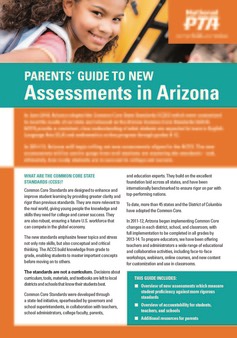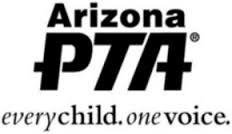Common Education Standards: What You Need to Know
Arizona Common Core State Standards Assessment and Accountability guide
 Arizona PTA is pleased to announce the release of the Arizona Common Core State Standards Assessment and Accountability guide. This new resource will serve as a valuable tool as the state of Arizona begins to transition to the new Common Core aligned assessments and will function as an important companion to the original Parents' Guide to Student Success.
Arizona PTA is pleased to announce the release of the Arizona Common Core State Standards Assessment and Accountability guide. This new resource will serve as a valuable tool as the state of Arizona begins to transition to the new Common Core aligned assessments and will function as an important companion to the original Parents' Guide to Student Success.
The assessment guide not only provides sample grade-level assessment questions, but also specifically outlines what parents can expect. In sum, the standards are new and the assessments of these standards will come with a new way of scoring. The new assessments measure deeper knowledge and skills deemed particularly important for students' futures, including problem-solving, writing, and critical thinking. Therefore, it is not possible to directly compare new scores with old. The guide provides parents with tools to support their child's learning at home and to collaborate with teachers during the assessment transition.
Download Assessment Guide guide here.
National PTA Position on Education Standards
National PTA volunteers have adopted several position statements and resolutions, beginning in 1981, in support of voluntary, clearer, higher academic standards for all students. National PTA’s position statement on Education Emphasis covers PTA’s position on voluntary standards. Specifically, National PTA:
- Supports nationally agreed upon voluntary standards if they are derived by consensus at the state and local levels. Parents must be involved in this process.
- Opposes federal legislation and/or regulations that mandate standardized testing or would lead to such testing, as well as federal policies that mandate comparisons of states, school districts, or individual schools and student retention based on a single test or sole criterion and the practice of social promotion.
- Believes that valid assessment does not consist of only a single test score, and that at no time should a single test be considered the sole determinant of a student's academic or work future.
GE Foundation Grant Helps National PTA Expand Common Core Work
GE Foundation Grant Helps National PTA Expand Common Core Work GE Foundation Grant Helps National PTA Expand Common Core Work To create state-specific assessment guides for paren ...
Two-page Parents' Guides to Student Success (Color)
Printable documents in English and Spanish that provides an overview of what your child will learn by the end of their grade year. Two-page Parents' Guides to Student Success (Color) Parent Guides - Printable Versions (Color) ...
Why do we have so many different sets of standards?
The U.S. Constitution gives each state control over its public education system; therefore, it is each state’s right to determine and define what students in each grade level should know and be able to do. As a consequence, there are 50 different sets of state education standards across the United States, meaning that there are different levels of expectations and goals for student learning.
As a teacher working in schools today, I know that education is the most powerful catalyst there is for helping children become productive and successful members of society. We need to prepare all of our children to enter and succeed in college and in meaningful careers. All children deserve equal access to an excellent education. Currently, however, children are taught at higher or lower levels based upon their zip code. Not only is this inacceptable on an ethical level, but also it gives the impression that we do not expect all students to contribute to society as productive citizens.
Establishing common education standards is one way we can work to address the disparity between standards to ensure that all children, regardless of geography, socioeconomic status, or life history, receive an education that values their potential.
Common standards are good for students because:
- They help prepare students with the knowledge and skills they need to succeed in college and careers.
- They help make transitions smoother for students moving to different states or districts because the learning goals remain consistent.
- Clearer standards help students understand what is expected of them and allow them to engage in more self-directed learning.
Common standards are good for parents because:
- They help parents understand exactly what students need to know and be able to do at each step in their education.
- They help facilitate conversation between parents and teachers about how to help their children reach those education goals.
- They assure parents that their children have access to the same high-quality education other students receive in other parts of the country.
Common standards are good for teachers because:
- They allow for more focused professional development and promote collaboration.
- They can inform the development of a curriculum that promotes deep understanding for all children.
- They can give educators more time to focus on depth of understanding and richer units of study rather than focusing on “fitting everything in.
